Double Headed Eagle
Since ancient times, the eagle has always represented the planet Jupiter and it still does to this very day. These Ancient 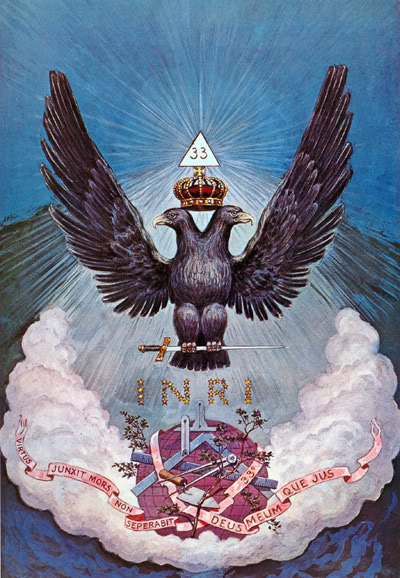 Symbols, such as the eagle has last the test of time because they are products of creation from the very same Brotherhood that has helped guide humanity through the darkness, by operating their light in the shadows over the last 3,000-5,000 years. Symbols, that have been placed everywhere around the world for those with any eye to see and the intuition to know.
Symbols, such as the eagle has last the test of time because they are products of creation from the very same Brotherhood that has helped guide humanity through the darkness, by operating their light in the shadows over the last 3,000-5,000 years. Symbols, that have been placed everywhere around the world for those with any eye to see and the intuition to know.
These are the immortal beings of time, whose souls originate from the King of Planets. Many very famous men in history and also the bible have claimed Jupiter as their father. People like the Sons of Noah, such as Japheth who in the seventh century, Isidore of Seville traced the origins of most of the nations of Europe back to Japheth. The Greek conqueror Alexander the Great and also the Roman Dictators, Julius and Augustus Caesar had claimed Jupiter as their father.
Author, Manly P. Hall who was also a 33° Freemason had written about these immortal beings in, The Lost Keys of Freemasonry; “These were the immortals to whom the term phoenix was applied, and their symbol was the mysterious two-headed bird, now called an eagle, a familiar and little understood Masonic emblem”.
The name Japheth /ˈdʒeɪfɛθ/ (Hebrew: יָפֶֿתֿ, יֶפֶֿתֿ Yapheth , Modern Hebrew: Yefet ; Greek: Ἰάφεθ Iapheth ; Latin: Iafeth or Iapetus ; Arabic: يافث) is derived from Ja—God, or life, and Phatha, which means in Hebrew enlarged, and in other languages, father; thus, Japheth meant enlarged of God—God and father, or Deus pater. Various spellings of Japheth are Japheta, Japeta, Japhe, or Jophe, or, as the Latins “Iu-Pater” (yēu-pəter or Iuppiter, Iūpiter – Pater/Father or the nominative: *Dyēus-pətēr, meaning “O Father Sky-God”, or “O Father Day-God”); He was the ruler of the lower world whom the Latins had called “Father Jove”, and this is where we get the modern English spelling of Jupiter, who in Christianity is Saint Peter.
The most ancient symbol of the double headed eagle has been in use and documented in stone for approximately 3,000-5,000 years. Today, it is used as an emblem of authority by the very same Brotherhood that descend from the first people for whom it had originated thousands of years earlier. It is most commonly associated with the Byzantine Empire, the Holy Roman Empire, the Russian Empire and their successor states. A Brotherhood that now spans the globe with its out stretched wings, touching one another from the East to the West.
The first evidence of the use of the double-headed eagle, I have found to originate with the Ancient Hittites who may also be connected with the Sumerians. The Hittites built a Lion Gate at Hattusas and a Sphinx Gate nearby at Alaca Höyiik in the late Mycenaean period (fourteenth century B.C.E.), with a Double Eagle carved on one side.
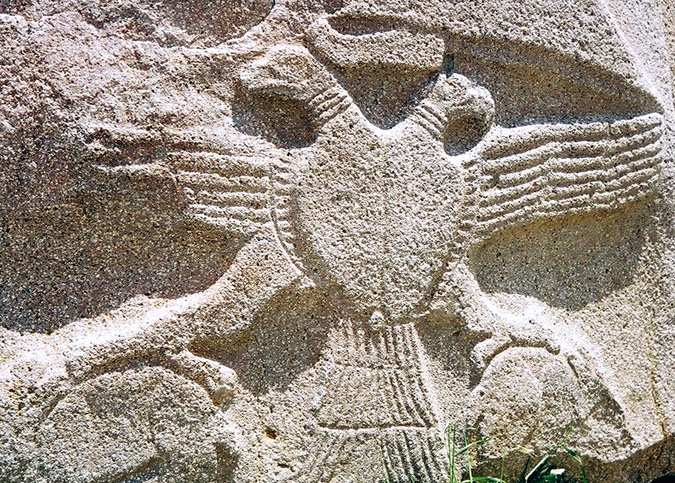
Evidence of these eagles were found on cylinders taken from the ruins of the ancient city of Lagash. The Hittites had worshiped the double headed eagle as the King of Heaven, who was also called the Hittite Bird of the Sun that was their symbol to signify Hittite military power. Today we know of the land of the Ancient Hittites as modern day Turkey, where you will find that the modern Turkish police have adopted the double-headed eagle in its insignia as a secondary charge.
The image and text below is from, “As it was in the beginning”, by T.R.Davies Coat of Arms No.109, Spring 1979 courtesy of The Heraldry Society;
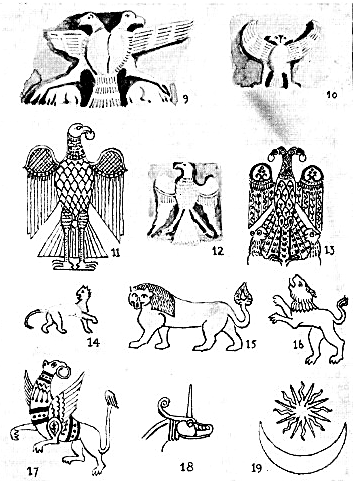 Fig. 9. Double eagle, Hittite 14th. C. B.C. — gateway, Alaya Hüyüt.
Fig. 9. Double eagle, Hittite 14th. C. B.C. — gateway, Alaya Hüyüt.
Fig. 10. Double eagle, Hittite 13th. C. B.C. — rock gallery Yazilikaya.
Fig. 11. Byzantine textile, 11th. C. A.D. — St. Germ. Auxerre.
Fig. 12. Eagle displayed, Byz. 10th. C. A.D. — stone, B. Mus.
Fig. 13. Double eagle, Byz. 9th. C. A.D. based on the Alaya relief above, even to the crouching beasts beneath the talons
Fig. 14. Lion of curious gait, 6th. C. A.D. — mosaic, Istanbul.
Fig. 15. Lion of curious gait, 11th. C. A.D. — Byz. text, copied from Persian relief, Düsseldorf Mus.
Fig. 16. Lion rampant, Byz. text. 8th. C. A . D . — Lyons Mus.
Fig. 17. Griffin segreant, Byz. text. 7th. C. A.D. St. Urs. Köln, note that the Byz. griffin is among the first mythical beasts as a heraldic charge, long pre-dating the West European dragon.
Fig. 18. Head of a unicorn, Babyl. 6th. C. B.C., copied in Byz. art.
Fig. 19. The sun of Apollo and the moon of Artemis were the symbols of the protecting deities of pagan Byzantium and were retained by Christian Constantinople.
In the modern world we live in now, the emblem of the double headed eagle signifies the dominance of the Byzantine Emperors over both East and West. The double-headed eagle emblem of the Byzantine Empire shows in one claw a cross and the other an orb—a symbol of spiritual and secular authority. Their origins lie in the ancient Christian Church, and they maintain many traditions practiced in the Ancient Church. Several Eastern European nations adopted it from the Byzantines and continue to use it as their national symbol to this day.
The double headed eagle below is the Seal of the Ecumenical Patriarchate of Constantinople.
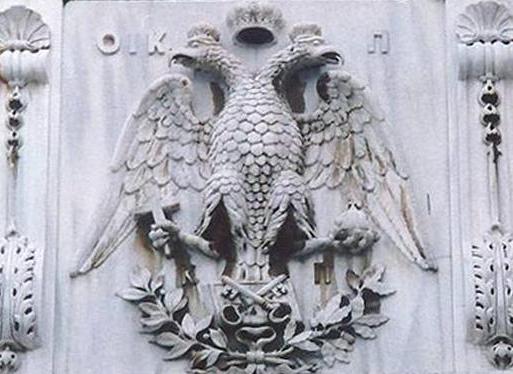
The Flag of the Greek Orthodox Church.
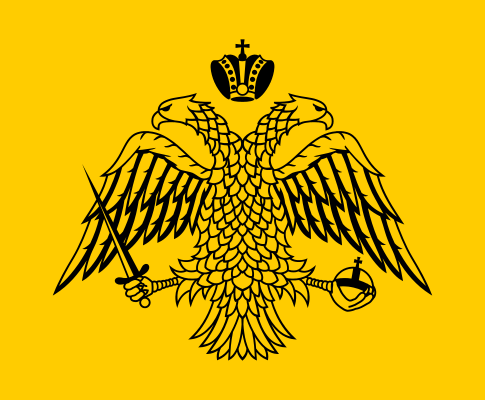
The Church of the Holy Sepulchre is one of the most Holy sites in all of the Christian world. Roman emperor Constantine had established the Church in the year 333 A.D., after his mother, Queen Helena, marked the place of Golgotha during her visit in 326AD.
The number 33 is often connected with the double headed eagle and a mosaic figure of a double headed eagle can be witnessed on the floor, in front of the chapel of the Holy Sepulchre.
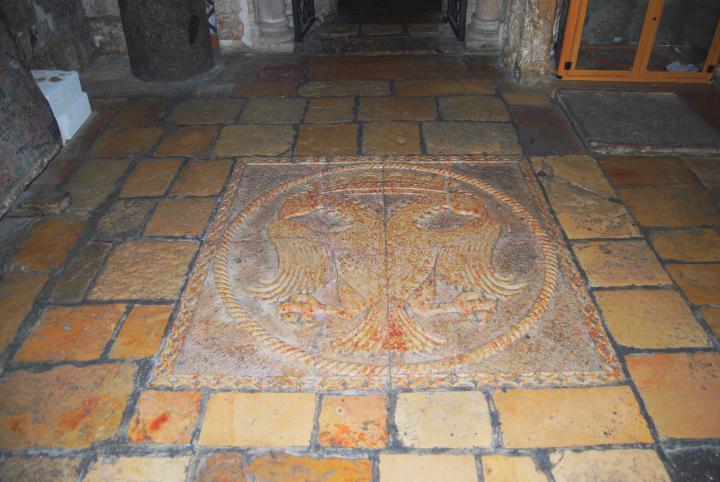
THE NUMBER 33 AND THE DOUBLE HEADED EAGLE
Jesus was crucified at Golgotha (place of the skull) at age 33 in the year 33 A.D. 33 represents Christ consciousness. Mount Hermon is at 33 degrees latitude and longitude. (In the Book of Enoch, Mount Hermon is the place where the Grigori; “Watchers, Sons of God or the Nephilim,” a class of fallen angels descended to Earth.) The divine name Elohim appears 33 times in the story of creation in the opening chapters of Genesis. The first Temple of Solomon stood for 33 years before being pillaged by King Shishak of Egypt. King David ruled over Israel for 33 years in Jerusalem. Alexander the Great (Alexander of Macedonia), a son of Jupiter had died at 33 years of age. Harry S. Truman, a 33 degree Mason, became 33rd President of the United States. In 1933, Adolf Hitler became Chancellor of Germany. The Grand Orient de France of Freemasonry founded in 1733.
The same number 33 is also the highest “honorary degree” of the ancient Brotherhood and Fraternity, that is known today as the Scottish Rite. When Scottish Rite Freemasonry had originated in the year 1758 in Paris, it was called “The Council of Emperors of the East and West.” The 33rd degree Council of Scottish Rite Freemasonry’s main symbol is also the same double headed eagle. The Latin words “Ordo Ab Chao” is seen displayed underneath this double headed phoenix. The English translation is “Order Out of Chaos or Order From Chaos.” It has been introduced in France in the early 1760s as the emblem of the Kadosh degree or Knight of the White and Black Eagle.
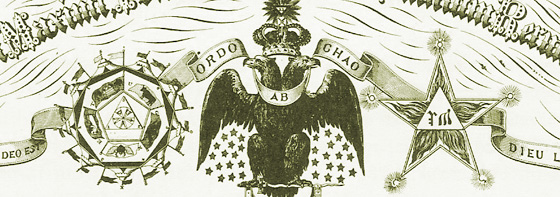
Council of Kadosh
The lesson of this degree is to be true to ourselves, to stand for what is right and just in our lives today. To believe in God, country and ourselves. There is no apron, but the jewel is a gold Teutonic cross, enameled in red, with the letters J.’.B.’.M.’. on the obverse, and a skull transpierced by a poinard on the reverse.
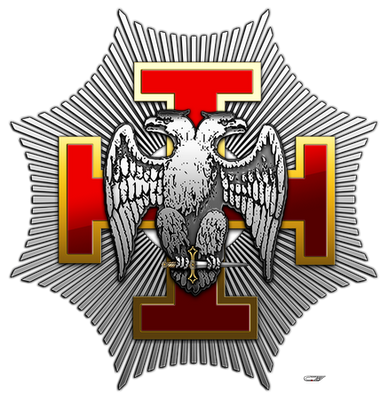
From the Masonic Dictionary;
The French records speak of seven: Kadosh of the Hebrews; Kadosh of the first Christians; Kadosh of the Crusades; Kadosh of the Templars; Kadosh of Cromwell or the Puritans; Kadosh of the Jesuits; and the True Kadosh. But the correctness of this enumeration is doubtful, for it cannot be sustained by documentary evidence. In all of these Kadoshes the doctrine and the modes of recognition are substantially the same, though in most of them the ceremonies of initiation differ.
Ragon mentions a Kadosh which is said to have been established at Jerusalem in 1118; but here he undoubtedly refers to the Order of Knights Templar.
Manly P. Hall, 33rd Degree Mason, had written in “The Lost Keys of Freemasonry”;
“The double-headed eagle was probably first accepted as a symbol of Freemasonry in 1758. In that year the body calling itself the Council of Emperors of the East and West, was established in Paris. The double-headed eagle was in all probability adopted by this body, which claimed a double jurisdiction. The eagle, one head inclined to the East and the other to the West, to guard any and all who might approach from either direction. The accepted symbol of our Rite is the Double-Headed Eagle of Lagash. It is the oldest crest in the world, according to fraternal scholars and was a symbol of power more than two thousand years before the building of King Solomon’s Temple.
“Among the ancients a fabulous bird called the Phoenix is described by early writers … in size and shape it resembles the eagle, but with certain differences. The body of the Phoenix is one covered with glossy purple feathers, and the plumes in its tail are alternately blue and red. The head of the bird is light in color, and about its neck is a circlet of golden plumage. At the back of its back the Phoenix has a crest of feathers of brilliant color …
The Phoenix, it is said, lives for 500 years, and at its death its body opens and the new born Phoenix emerges. Because of this symbolism, the Phoenix is generally regarded as representing immortality and resurrection … The Phoenix is one sign of the secret orders of the ancient world and of the initiate of those orders, for it was common to refer to one who had been accepted into the temples as a man twice-born, or reborn. Wisdom confers a new life, and those who become wise are born again.” [p. p. 176-77]
The Dukes of Bavaria are also descendants of the Byzantine emperors. Hence, it is quite possible that the Bavarian Illuminati may also be connected with the double headed eagle.
In the Holy Roman Empire’s heraldry, it represents the union of church and the state. The double headed Eagle signifies a double imperial power, and was for the use of emperors who claim to be the successor of the Caesars of Rome ; Thus the Eagle of the Eastern Empire united with that of the West, typifying the Holy Roman Empire, and is where we see the use of this double head.
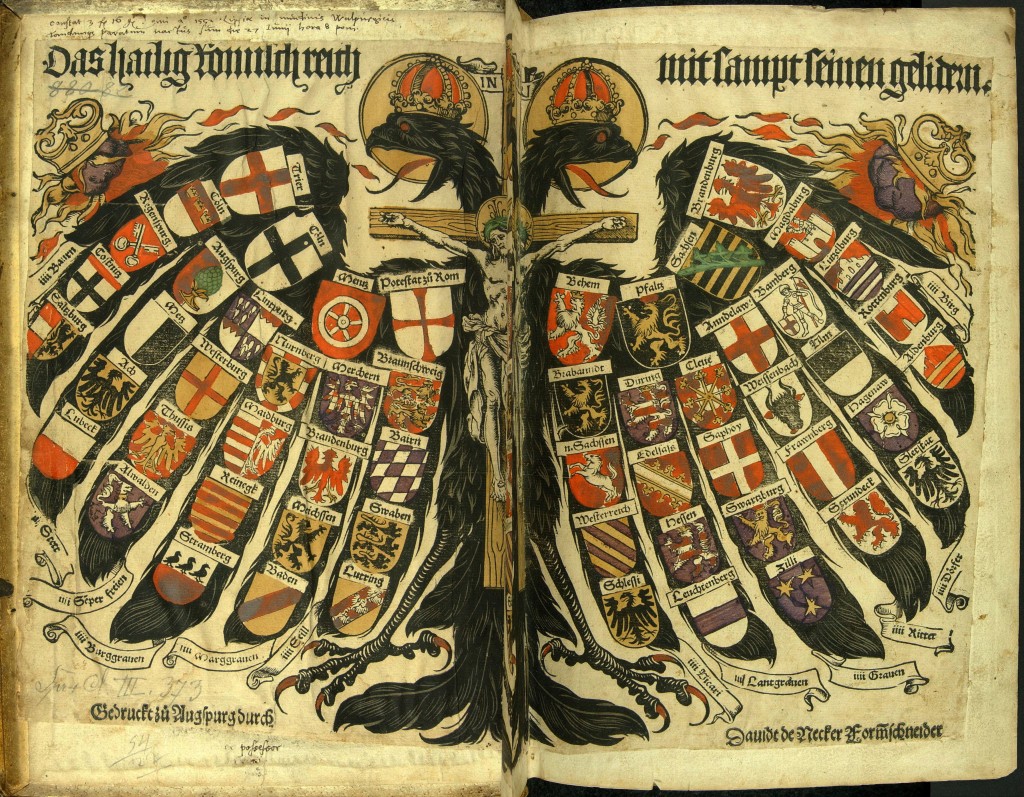
Charlemagne first made use of the double-headed eagle when he became head of the German Empire, the two heads denoting the union of Rome and Germany, in AD 802.
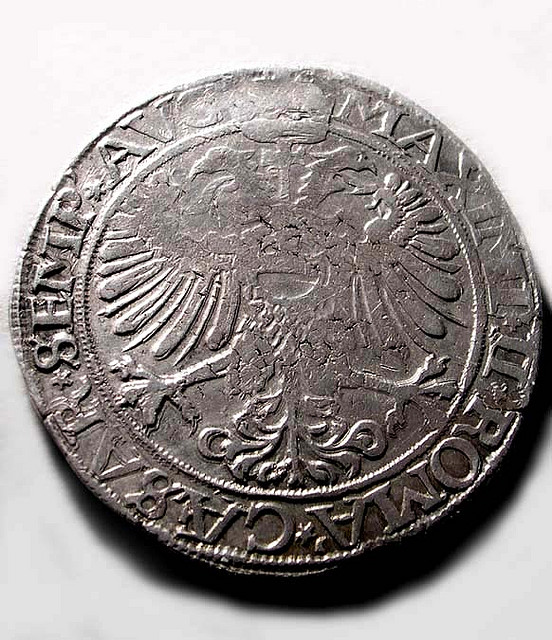
After the East West Schism, there was a division of the Roman Empire into the East and the West. The emperors of the West used a black Eagle, and those of the East a golden one; since which period Austria, Prussia, Russia, France, and also Poland, when a nation, have also used the Eagle as their royal emblem.
The two-headed mythological bird of Hindu mythology is thought to possess magical strength. It is used as the official emblem by the Karnataka government and it is seen as an intricately sculptured motif in Hindu temples

Below is a list of countries and entities that currently use the double headed eagle as their emblem;
Coat of arms of the Russian Empire
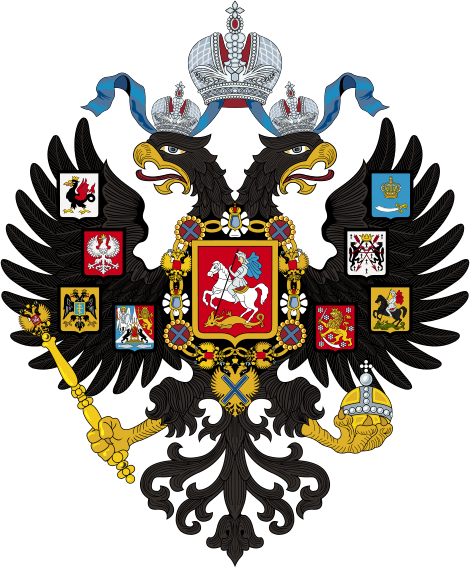
Imperial Coat of arms of the Austrian Empire
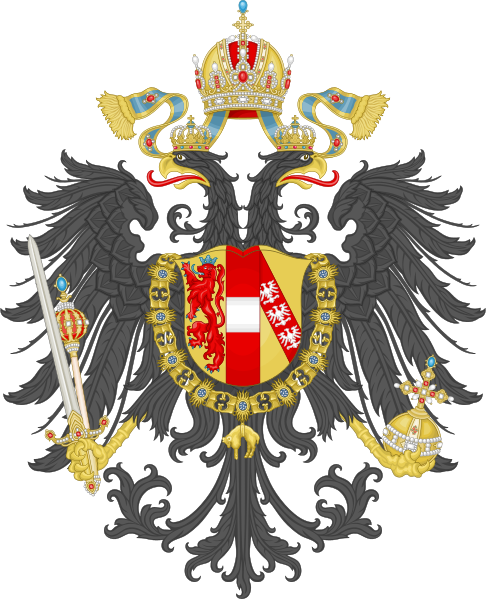
Current Flag of Albania
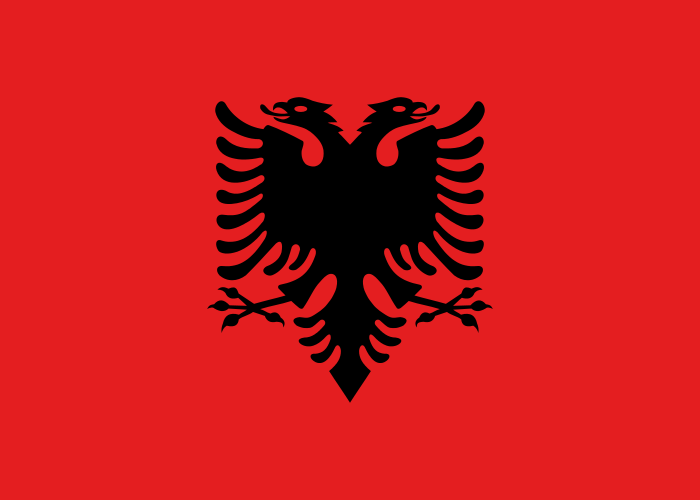
On March 27, 2006, Armenia signed a Millennium Challenge Compact with the United States; the agreement entered into force on September 29, 2006. Provided the Armenian Government makes progress on mutually agreed-upon policy performance criteria (corruption, ruling justly, and investing in people), the agreement will provide $235 million to Armenia over five years to reduce rural poverty through the improvement of rural roads and irrigation networks. In 2012 or 2013, US and Armenia are planning to hold their first ever joint military drills, during which Armenian soldiers will be trained for their current multi-national peacekeeping operations.(Wikipedia)
OTHER COUNTRIES:
Armenia – The double-headed eagle was also in use by the Arsacid Dynasty of Armenia in the 3rd to 9th centuries.
Austria (1934–1938)
Austria-Hungary
Byzantine Empire
German Confederation
In modern Greece it is used officially by the Hellenic Army (Coat of Arms of Hellenic Army General Staff)
Holy Roman Empire
Kingdom of Mercia (527–918)
Montenegro, Kingdom of Mysore
Russian Federation
Seljuk Empire
Serbia
Serbian Empire
Kingdom of Serbia
Spanish Empire (during the Habsburg dynasty)
Kingdom of Yugoslavia

